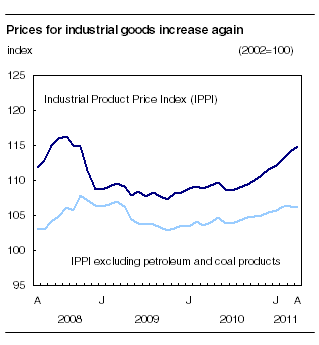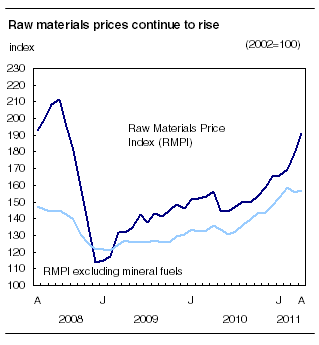Industrial product and raw materials price indexes
Archived Content
Information identified as archived is provided for reference, research or recordkeeping purposes. It is not subject to the Government of Canada Web Standards and has not been altered or updated since it was archived. Please "contact us" to request a format other than those available.
Related subjects
-
[an error occurred while processing this directive]
In April, the Industrial Product Price Index (IPPI) increased 0.5% compared with March, led by higher prices for petroleum and precious metals. The Raw Materials Price Index (RMPI) rose 6.8% as a result of a strong upward movement in crude oil prices. The overall increase in the RMPI was moderated by a sharp decline in radioactive concentrates.
The IPPI posted a growth rate of 0.5% in April, slower than those of 0.8% in February and 1.0% in March. The gain in April was primarily driven by a 4.2% increase in petroleum and coal products and a 1.9% rise in primary metal products. Chemical products (+0.7%) and meat, fish and dairy products (+0.6%) contributed more modestly to the increase.

Prices for petroleum and coal products increased in April, but at a more moderate pace than the 8.2% observed in March.
Note to readers
All data in this release are seasonally unadjusted and are usually subject to revision for six months (for example, when the July index is released, the index for the preceding January becomes final). Exceptionally, the September 2010 data have been revised. This revision happened one month outside of the usual revision period and has no impact on the percentage changes reported in any Daily releases.
The Industrial Product Price Index (IPPI) reflects the prices that producers in Canada receive as the goods leave the plant gate. It does not reflect what the consumer pays. Unlike the Consumer Price Index, the IPPI excludes indirect taxes and all the costs that occur between the time a good leaves the plant and the time the final user takes possession of it, including the transportation, wholesale, and retail costs.
Canadian producers export many goods. They often indicate their prices in foreign currencies, especially in US dollars, which are then converted into Canadian dollars. In particular, this is the case for motor vehicles, pulp, paper and wood products. Therefore, a rise or fall in the value of the Canadian dollar against its US counterpart affects the IPPI. But the conversion into Canadian dollars only reflects how respondents provide their prices. Moreover, this is not a measure that takes into account the full effect of exchange rates, since that is a more difficult analytical task.
The conversion of prices received in US dollars is based on the average monthly exchange rate (noon spot rate) established by the Bank of Canada, and it is available on CANSIM in table 176-0064 (series v37426). Monthly and annual variations in the exchange rate, as described in the text, are calculated according to the indirect quotation of the exchange rate (for example, CAN$1=US$X).
The Raw Materials Price Index (RMPI) reflects the prices paid by Canadian manufacturers for key raw materials. Many of those prices are set on the world market. However, as few prices are denominated in foreign currencies, their conversion into Canadian dollars has only a minor effect on the calculation of the RMPI.
In April, prices for primary metal products rose 1.9% and registered their 10th consecutive advance. Silver and platinum (+19.0%) as well as precious metal basic manufactured shapes (+15.0%) grew sharply, while copper, iron and steel, and aluminum products made very modest gains. On the other hand, the upward movement in primary metal products was dampened by a 3.8% decline in nickel products. Reduced production in Asia continued to negatively affect the demand for metals.
The IPPI advance was moderated by a 1.0% decline in prices for motor vehicles and other transport equipment. The decrease was largely the result of the 1.9% appreciation of the Canadian dollar against the US dollar.
Some Canadian producers who export their products to the United States are generally paid on the basis of prices set in US dollars. Consequently, the strength of the Canadian dollar in relation to the US dollar had the effect of reducing the corresponding prices in Canadian dollars. Without the impact of the exchange rate, the IPPI would have risen 1.0% instead of 0.5%.
In April, excluding petroleum and coal products, the IPPI decreased 0.1% after remaining unchanged in March.
12-month change in the IPPI: The upward trend continues
The IPPI rose 5.0% in April compared with the same month a year earlier, after advancing 3.7% in February and 5.0% in March. Of the 21 major commodity aggregations, 16 were up and 5 decreased, which is comparable to the distribution in March.
In the past 12 months, the IPPI advance was driven mainly by higher prices for petroleum and coal products (+28.7%) and primary metal products (+12.3%).
Year over year, the largest contributors to the increase in primary metal products were precious metals, particularly silver and platinum (+104.8%), as well as precious metal basic manufactured shapes (+103.0%). Copper and iron and steel products played a less important part, with respective increases of 13.1% and 3.8%.
Chemical products (+4.9%) and fruits, vegetables, feeds and other food products (+6.2%) made smaller contributions to the IPPI growth.
In April, the 4.9% year-over-year increase in the value of the Canadian dollar relative to the US dollar dampened the IPPI advance. Without the impact of the exchange rate, the IPPI would have risen 6.1% instead of 5.0%.
Prices for motor vehicles and other transport equipment, which are particularly sensitive to the exchange rate, fell 2.3% in April compared with the same month a year earlier, continuing the downward movement that started in October 2009.
Excluding petroleum and coal prices, the IPPI increased 2.1% year over year in April, a rate of growth similar to those observed in January and February, but inferior to that of 2.6% in March. This index has recorded year-over-year increases since May 2010.
Raw Materials Price Index: The upward trend intensifies for a third month
The Raw Materials Price Index (RMPI) rose sharply by 6.8% in April, compared with increases of 2.2% in February and 5.8% in March. The RMPI growth was primarily driven by mineral fuels (+13.2%). Following a 16.2% increase in March, crude oil prices rose 14.1% in April. The crude oil price index was 32.8% higher than in January.

Price increases for animals and animal products (+1.6%), vegetable products (+1.4%) and wood products (+1.8%) contributed more modestly to the RMPI advance in April.
Non-ferrous metals (-0.6%) slightly dampened the impact of higher crude oil prices on the RMPI.
The drop in prices for non-ferrous metals in April was driven by a sharp decline in the price of radioactive concentrates (-17.3%), which resulted from the earthquake and the tsunami in Asia in March. The decrease in radioactive concentrates offset the advances of all other metals. With the exception of radioactive concentrates, prices increased for all non-ferrous metals, particularly precious metals (+7.4%).
Excluding mineral fuels, the RMPI increased 0.6% in April, following a 1.8% decline in March.
Compared with the same month a year earlier, the RMPI was up 22.4% in April, following gains of 11.4% in February and 16.8% in March. Year over year, the RMPI has been on an upward trend since November 2009. The main contributors to the RMPI year-over-year increase in April were mineral fuels (+30.0%), non-ferrous metals (+17.2%), vegetable products (+40.3%) and animals and animal products (+9.7%).
Excluding mineral fuels, the RMPI recorded a year-over-year increase of 15.1% in April, slower than the growth rates of 20.0% in February and 17.2% in March.
Available on CANSIM: tables 329-0056 to 329-0068 and 330-0007.
Tables 329-0056: Industrial Product Price Index by major commodity aggregations.
Table 329-0057: Industrial Product Price Index by industry.
Table 329-0058: Industrial Product Price Index by stage of processing.
Tables 329-0059 to 329-0068: Industrial Product Price Index by commodity.
Table 330-0007: Raw Materials Price Index by commodity.
Definitions, data sources and methods: survey numbers, including related surveys, 2306 and 2318.
The April 2011 issue of Industry Price Indexes (62-011-X, free) will soon be available.
The industrial product and raw material price indexes for May will be released on July 4.
For more information, or to enquire about the concepts, methods or data quality of this release, contact Client Services (toll-free 1-888-951-4550; 613-951-4550; fax: 613-951-3117; ppd-info-dpp@statcan.gc.ca), Producer Prices Division.
- Date modified:
